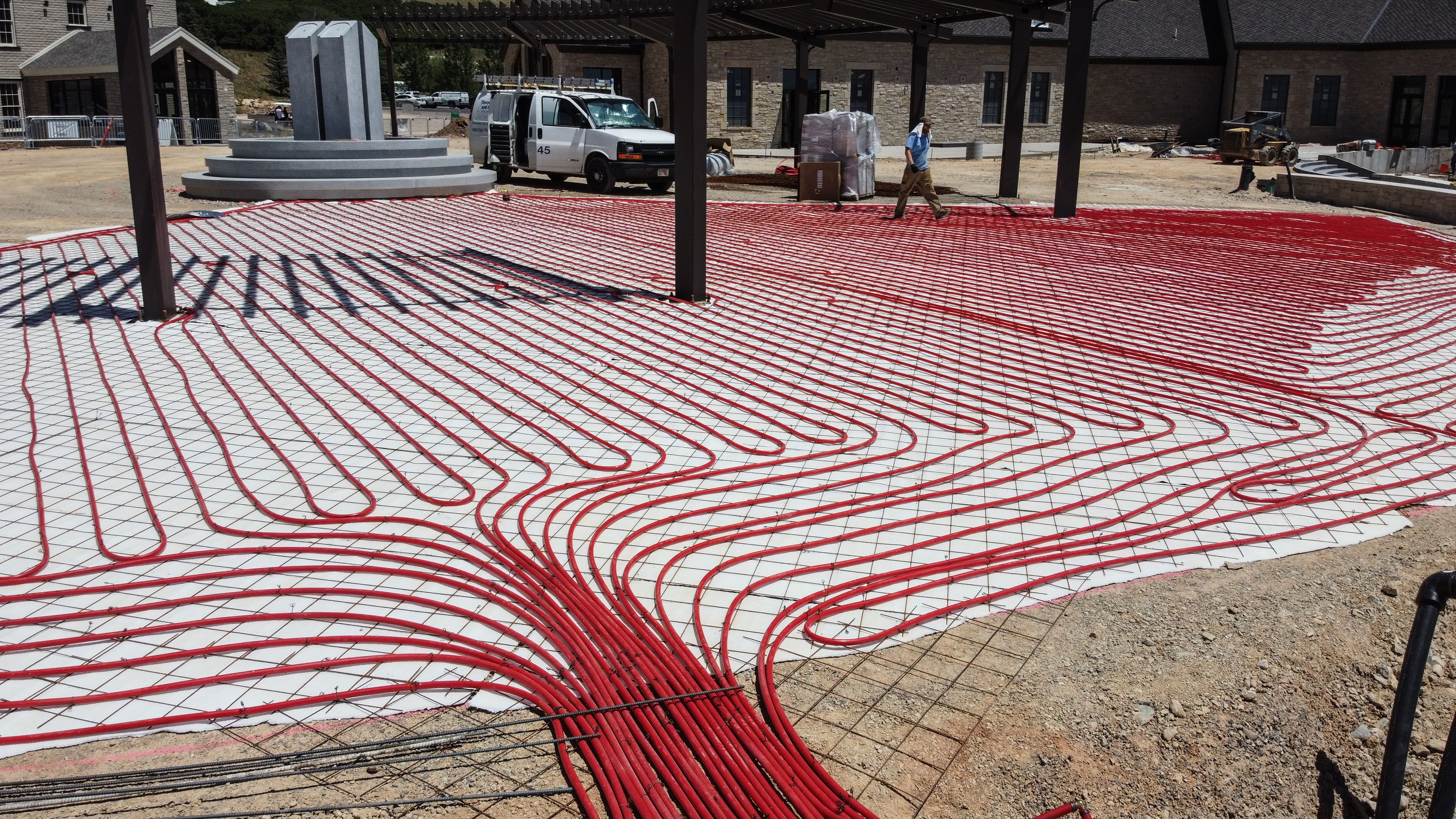The modern solution for defeating ice and snow to make areas safe for visitors to a new historical site in Salt Lake City required a hydronic snow- and ice-melt system. More than 40,000 feet of crosslinked polyethylene (PEX) barrier tubing was installed in 165 loops serviced by nine custom-made manifolds. The system also saved 30,000 square feet of new concrete from salt damage.
This Is The Place Heritage Park, a 450-acre living history Utah State Park, offers visitors a look at life in 19th-century Utah from the Mormon arrival in 1847 to statehood in 1896. The location of the park is where, on July 24, 1847, Brigham Young first saw the Salt Lake Valley after a 1,300-mile journey. It would soon become the new home for the Mormon pioneers.
Located on the east side of Salt Lake City at the foot of the Wasatch Range and near the mouth of Emigration Canyon, the park sees more snow and higher winds than the surrounding area. The blowing and drifting snow accumulates in different spots, compounding the problems for snow removal crews as well as creating obstacles for visitors.
“This is one of the largest snow/ice-melting systems in the area,” explains David M. Fink, president of the Plastics Pipe Institute (PPI), a North American trade association representing the plastic pipe industry. “We continually see the growing use of hydronic systems because of the practicality, efficiency and cost-effectiveness. This includes the low maintenance required during a very long-use life. We have heard that this system has exceeded expectations in its ability to melt blowing snow.”
As it is with all facilities in cold climates, the concern during the design of This Is The Place Heritage Park was the safety of visitors during periods of ice and snow. Using traditional methods of salt or other types of ice melt plus equipment were considered expensive and could damage the new concrete.
“In a hydronic snow- and ice-melting (SIM) system, a heated water/glycol solution is circulated through a network of pipe embedded in an outdoor area to melt snow and ice, leaving areas dry,” explains Lance MacNevin, P. Eng., director of engineering for PPI’s Building & Construction Division (BCD). “The flow of the heated fluid can be controlled by advanced outdoor sensors to only operate when needed, using no energy when not operating.
“The energy produced in high-efficiency boilers is used to warm the outdoor surfaces to approximately 36 F (2 C), minimizing energy consumption when in operation.”
Designing a Large SIM System
Valentiner Construction (Midway, Utah) was the general contractor for the new 12,000-square-foot Welcome Center and surrounding plaza.
“The chief executive officer of the park had found a solution for his home driveway, which was an outdoor SIM system,” notes Kaj Valentiner, project foreman for Valentiner Construction. “He thought that an equally effective solution could be applied to the walkway areas around the park’s Welcome Center, even though the area is many times larger.
“He knew there would be significant time and expense to remove snow and ice using traditional methods, and also had seen firsthand how badly salt can damage concrete, with the unsightliness and the need for continuous repairs. We were about to lay 30,000 square feet of new concrete, so we sure wanted to avoid all that.”
Thornton Plumbing & Heating (Midvale, Utah), a third-generation family business with decades of experience in installing SIM systems from driveways to large ski resorts, was brought in to team with Valentiner on the project.
Thornton Vice President Chris Barker says the project would be at the high end of the size scale for SIMs. “A typical SIM project averages around 10,000 square feet,” he explains. “This one, as designed, would encompass a large circular area of nearly 30,000 square feet.”
The project uses 40,173 feet (12,245 meters) of 3/4-inch RAUPEX PEXa oxygen-barrier tubing in 165 circuits serviced by nine custom-made manifolds. Three NTI FTG 2000 high-efficiency, stainless-steel boilers, located in the Welcome Center’s mechanical room, provide up to 6 million BTUs of energy.
Heated fluid is transferred to the remote manifolds for the SIM area through 4,000 feet (1,219 meters) of 2-inch-diameter, high-density polyethylene (HDPE) buried piping. Two tekmar 654 snow-melting controls with slab sensors automatically turn the system on and off.
“The durability and flexibility of PEXa tubing simplified this large-scale hydronic installation for the mechanical contractor, helping the crew stay on schedule and deliver an efficient SIM system that surpassed the expectations of the owner,” MacNevin reports. “Considering the circular shape of the area, it was appreciated that the PEX tubing remained flexible even at cold installation temperatures.
“And the enormous scope of the job is worth noting. For example, makeshift roads had to be built to get concrete trucks close enough to pump-in spots while facing challenges in coordinating schedules between SIM installers and concrete installers. Just-in-time delivery of the 40,000 feet of tubing from REHAU prevented it from becoming a roadblock on the site.”
The snow-melt project was named 2021 Project of the Year for PPI’s Building & Construction Division. The association’s annual awards program recognizes projects and members for exceptional contributions to the industry. Submissions in the association’s divisions are reviewed, evaluated and voted upon by PPI members.
“We are happy that the CEO of this park recognized the inherent safety benefits of a hydronic snow- and ice-melting system, especially for a project intended to be used by the public throughout the year,” MacNevin says. “It is definitely worthy of receiving the PPI BCD Project of the Year Award.”
Steve Cooper has reported on a variety of plumbing, construction and infrastructure projects for several decades. Based in New York, he has traveled extensively to conduct on-site news interviews with professional engineers, contractors, government officials and representatives of major companies supplying the industry. He can be reached at 516/623-7615 or [email protected].





